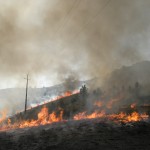23 April 2013
WASHINGTON—When scientists torched an entire 22-acre watershed in Portugal in a recent experiment, their research yielded a counterintuitive result: Large, hot fires do not necessarily beget hot, scorched soil.

During an experimental burn in Portugal, researchers find that hot, intense fires yield cooler underlying soil than expected. (Credit: Cathelijne Stoof)
It’s well known that wildfires can leave surface soil burned and barren, which increases the risk of erosion and hinders a landscape’s ability to recover. But the scientists’ fiery test found that the hotter the fire—and the denser the vegetation feeding the flames—the less the underlying soil heated up, an inverse effect which runs contrary to previous studies and conventional wisdom.
Rather, the soil temperature was most affected by the fire’s speed, the direction of heat travel and the landscape’s initial moisture content. These new findings could help forest managers plan when and where to ignite small controlled burns to reduce dry vegetation and restore the ecosystem in at-risk areas, said Cathelijne Stoof, the soil and water scientist who led this study as part of her PhD research at Wageningen University in the Netherlands.
A report about the experiment by Stoof, who is now at Cornell University in Ithaca, New York, and her colleagueshas been accepted for publication by Geophysical Research Letters, a journal of the American Geophysical Union.
To study the real-world effects of landscape and fire dynamics on soil temperature, the research team mapped the watershed and installed instruments before setting the test area ablaze. During the burn the scientists monitored the fire and the resulting soil temperatures. As expected, the fire was most intense in the heavily vegetated areas, but the topsoil in these regions remained “surprisingly cool” during the duration of the fire, Stoof explained.
“Vegetation is fuel, so the areas with more vegetation had more intense fire,” Stoof said. “But the heavily vegetated regions also were also more moist, which protected the soil.”
The areas with the hottest soil temperatures were in direct sunlight and had sparse, dry vegetation. “Because it’s already dried out, it doesn’t have the moisture shield that more densely vegetated areas have to preserve the soil,” Stoof said.
Other, previously observed behavior of fires could also help explain the new result, Stoof added. “Fires moving fast will quickly burn up all the vegetation and also have little effect on the soil, but slow-moving fires will have much more time to heat up the soil and burn up its organic matter and seeds,” she noted.
Prior to this study, most of the research concerning fire effects on soil “took place in small scale field or laboratory settings, where they only burned small plots,” Stoof said. “But these plots have less variation than a real watershed. If you have homogeneous conditions, you cannot extrapolate those results to the larger scale, where fire, soil and vegetation are heterogeneous.”
Fire researcher Guillermo Rein of the Imperial College, London, called the results from Stoof and her colleagues “thought-provoking.” They “go against the currently prevalent theory of soil heating,” he said. “This paper ought to quickly mobilize the fire science community so that this soil heating theory can be reconfirmed, refuted or reformulated.”
From the new results, Stoof has devised a strategy to minimize soil damage during controlled burns. “You need to burn heterogeneous areas in two stages,” Stoof said. “Burn the driest area first when it has some moisture. The damp area will be too damp, and therefore will not carry fire. Then go back and burn the damp area when it’s dried out enough so that it will burn. This way you end up with minimum soil damage.”
But in order to apply the results of this study universally, soil and fire scientists need to work together and study other types of landscapes, Stoof added. “We just studied one type of environment and one fire. This experiment needs to be replicated so we can understand how different vegetation and soil types are affected. If soil scientists work with fire scientists, they can predict where the damage is going to occur and put up barriers to prevent erosion, or plan prescribed burns strategically to minimize soil depletion.”
A scholarship from the International Association of Wildland Fire and a European Commission contract funded this work.
Joint Release:
AGU Contact:
Sarah Charley, +1 (202) 777-7516, [email protected]
Peter Weiss, +1 (202) 777-7507, [email protected]
Cornell University Press Relations Office Contact
John Carberry, +1 (607) 255-5353, [email protected]
Journalists and public information officers (PIOs) of educational and scientific institutions who have registered with AGU can download a PDF copy of this accepted article by clicking on this link:
http://onlinelibrary.wiley.com/doi/10.1002/grl.50299/abstract
Or, you may order a copy of the final paper by emailing your request to Sarah Charley at [email protected]. Please provide your name, the name of your publication, and your phone number.
Neither the paper nor this press release are under embargo.
“Hot Fire, Cool Soil”
- Cathelijne R. Stoof
- Department of Biological and Environmental Engineering, Cornell University, Ithaca, NY, USA, Land Degradation and Development Group, Wageningen University, Wageningen, The Netherlands, and Centro de Estudos de Recursos Naturais, Ambiente e Sociedade, Escola Superior Agrária de Coimbra. Bencanta, Coimbra, Portugal;
- Demie Moore
- Land Degradation and Development Group, Wageningen University, Wageningen, The Netherlands;
- Paulo M. Fernandes
- Centro de Investigação e de Tecnologias Agro-Ambientais e Biológicas, Universidade de Trás-os-Montes e Alto Douro. Vila Real, Portugal;
- Jetse J. Stoorvogel
- Land Dynamics Group, Wageningen University, Wageningen, The Netherlands;
- Ricardo E.S. Fernandes
- Gabinete Técnico Florestal, Câmara Municipal da Lousã, Rua Dr. João Santos, Lousã, Portugal;
- António J.D. Ferreira
- Centro de Estudos de Recursos Naturais, Ambiente e Sociedade, Escola Superior Agrária de Coimbra. Bencanta, Coimbra, Portugal;
- Coen J. Ritsema
- Land Degradation and Development Group, Wageningen University, Wageningen, The Netherlands, and Soil Physics and Land Use Team, Alterra Green World Research, Wageningen UR, Wageningen, The Netherlands.
Cathelijne Stoof, Email: [email protected]